WHAT'S NEW:
Deepsea Image Galleries on Multimedia page
(posted 9/15/98)
Eruption Confirmed!
New lava (rumbleometer stuck in flow) SE rift zone
(posted 9/1/98)
BACKGROUND:
Technology (ROV, ships, etc.)
Other 1998 Axial cruise reports
EXPEDITION:
Science Objectives
Calendar
Today's Science News
Participant Perspective
Teacher Logbook
EDUCATION:
Curriculum
Teacher Observations
Questions/Answers from sea
MULTIMEDIA:
(video clips, animations, sounds)
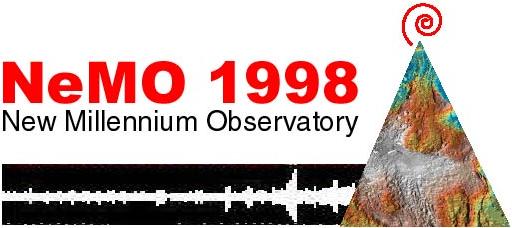
Life At Sea Perspective
August 25, 26, 27 28, 29, 30, 31, September 1, 2, 3, 4, 5, 6, 7, 8, 9, 10, 11, 12, 13, 14, 15, 16, 17, 18, 19
Septemer 19
Susan Merle
OSU/NOAA Vents Program, Newport Oregon

Hi! My name is Susan Merle. I'm a geological oceanographer. For the last year it has been my pleasure to work as Bob Embley's research assistant at Hatfield Marine Science Center in Newport Oregon. I'm employed by Oregon State University, working with NOAA/PMEL in the VENTS program.
I have been working in my field for the last seven years. I was a late bloomer, it's never too late to get that degree. Most of my career was spent in the commercial field working for a seafloor survey company in Seattle, processing sidescan sonar data. I spent quite a lot of time at sea (more than 20 cruises) doing fibre-optic cable surveys, pipeline surveys, etc. while working out of Seattle. That job allowed me to travel extensively out of the country on foreign vessels, with foreign crews. The cultural experiences were irreplaceable. The travel was exciting though over the years my wanderlust ebbed, so when I heard there was an opening at Hatfield I decided it was time for a change. I haven't looked back.
Working with a great group of dedicated scientists in the VENTS program has been a fulfilling experience. I particularly enjoy being able to "do science" again, and feel I am constantly learning new things on the job. I'm thankful to Bob Embley and Bill Chadwick for their patience with me as I've tried to catch up on all the exciting work we do. My job is never boring. I perform a wide variety of tasks such as: bathymetric and sidescan sonar mapping, working on figures for publications, making posters for presentations , working with video data, and learning how to operate the SeaBeam multibeam sonar system. Gene Williamson and myself are also working with Andra Bobbitt at Hatfield to bring you the NeMO website.
Which brings me to the NeMO98 cruise. This is my first submersible cruise and ROPOS has been amazing. While sitting in front of the navigation computer trying to figure out where the sub is, I've seen some incredible sights ranging from black smokers to diffuse vents, and all the animals associated with these vent communities. One truly feels like they are right there in the caldera with the sub. Absolutely the most incredible cruise I've been on. Combine the exciting work, a group of dedicated scientists for colleagues, and the pleasure of living on the beautiful Oregon Coast, and I must say I've got it good. I'm hoping the VENTS program continues for many years to come.
Septemer 18
Elizabeth Guenther
Moss Landing Marine Laboratory and
Stacey Maenner
NOAA Corps Officer,
Vents Prorgram
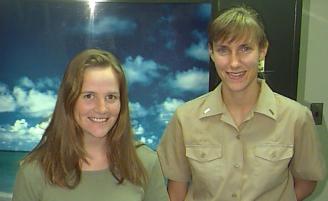
Hello everyone, it is September 18, 1998. We are reaching the end of our vents cruise now. We only have 2 days left and only 1 of those will be used for diving with the submersible ROPOS. It has been a very productive cruise for all those involved. I myself (Elizabeth Guenther, Moss Landing Marine Laboratory) am almost done with my work. Today I will be receiving my last set of samples from the Fluid Sampler. I look at the chemistry of the water samples, specifically the salinity, nitrate and sulfide concentrations at the various vent sites. My work is different from that of the other scientists on board in that I am working on a new method for measuring those three things. Right now it is still a work in progress, but I can tell you that it will make things much easier in the future of vent chemistry analyses if it works as well as I hope.
That isn't all I have been doing on this cruise though. I have been helping
with the video taping of the dives. My watch is from 4am to 8am every day. Of
course the ROPOS isn't always in the water at that time so I get a break once in
a while. When I am not busy doing work I find time to relax by watching a movie
in the TV room. There is a wide selection of movies available and they play 2
movies every night for anyone who wants to relax a little and get away from the
work that keeps them so busy the rest of the time.
Elizabeth Guenther
Hello, my name is Stacy Maenner and I am a NOAA Corps Officer currently assigned to the Pacific Marine Environmental Laboratory. While Elizabeth is helping with the video tapes of the dives, I am trying to log all the comments that are being made in the ROPOS room by all the scientists. It can be quite a challenge at times when everyone gets really excited over new discoveries and starts talking at once. I need to log everything from new findings to pictures of Mr. Potato Head to aggressive sulfide worms that make the WWF look wimpy! My main responsibility on the cruise, however, is assisting Gary Massoth with SUAVE (see August 30). SUAVE provides a lot of interesting and exciting real time data that many scientists use to understand more about the life at hydrothermal vents. I also analyze water samples collected from the CTDT/Rosette for trace levels of iron and manganese. If we are fortunate, then the samples were taken from a hydrothermal plume. For more information on CTDT and hydrothermal plumes, see Betsy McLaughlin-West (29 August). I have really enjoyed my time on this cruise. I still find it fascinating that we are able to guide a remotely operated vehicle more then a mile deep in the ocean and at the same time make observations such as hot fluid venting from the seafloor, life surviving in extreme environments and new lava formations.
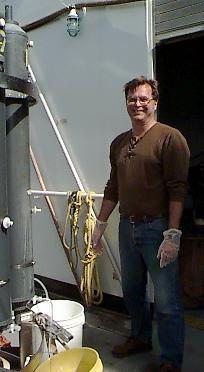 Septemer 17
Septemer 17
Jim Gendron
NOAA Vents Program, Seattle
My name is Jim Gendron. I am an oceanographer with NOAA's Pacific Marine Environmental Lab in Seattle. My main interest is the 'smoke' that forms above the hydrothermal sources. This hydrothermal particulate is composed of very small grains of material that precipitate rapidly after leaving the vent. As the particles form they become the characteristic rising plume that you see. Just like smoke from a smokestack, this plume can ascend up to 200 meters from it's source.
How do you detect such a plume?
One of the instruments on the CTD is called a nephelometer. It shines a
light into the water and then detects any light that is scattered back to
it's sensor. The brighter the returning light signal is, the more particles
there are.
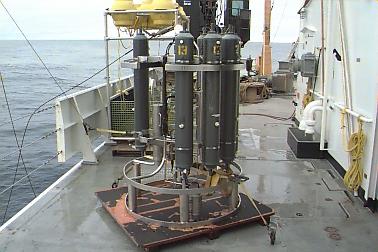
How do you collect samples of the particles? Samples can be collected using the Niskin bottles on the CTD (gray, tubular items in photo on left), or by mounting Niskins directly on ROPOS. The fluid sampler on ROPOS can also be used to filter the plumes in place. In all cases the samples are filtered onto plastic membrane filters. Then they are dried and kept under a vacuum until they are brought back to the lab in Seattle.
How do you analyze the samples? Each sample is placed in a instrument that blasts it with X-rays. The sample will then give off new X-rays that can be used to tell what elements are present and how much of each element is in the sample.
What elements do you find in the 'smoke'? The most important elements are iron, sulfur, zinc, copper, silica, manganese and phosphorus. The orange-brown color that you can see in much of the sediment cover on the basalt is probably due to iron.
Consider the following: These hydrothermal vent systems were not discovered until after humans had walked on the moon.
Septemer 16
Julia Getsiv
Graduate Student,
Vanderbilt University
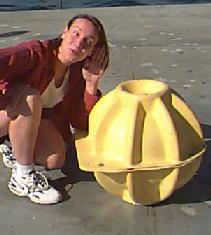 Hello! My name is Julia Getsiv and I am a graduate student working towards my
masters degree in geology at
Vanderbilt University. Although my thesis work is
in an area far, far away on a mid-ocean ridge in the Atlantic Ocean, my heart
and soul are still deeply linked to the
Juan de Fuca Ridge and
Axial Volcano. I
got my bachelors of science degree in geological oceanography five years ago and
immediately following began working for
Bob Embley as his research assistant.
Hello! My name is Julia Getsiv and I am a graduate student working towards my
masters degree in geology at
Vanderbilt University. Although my thesis work is
in an area far, far away on a mid-ocean ridge in the Atlantic Ocean, my heart
and soul are still deeply linked to the
Juan de Fuca Ridge and
Axial Volcano. I
got my bachelors of science degree in geological oceanography five years ago and
immediately following began working for
Bob Embley as his research assistant.
Two weeks into my budding career with NOAA, twenty-five scientists embarked upon the first event response voyage to a volcanic eruption detected just north of Axial Volcano on the Juan de Fuca ridge. Since that first cruise, one of my duties at sea has been to aid in the navigation of vehicles, like ROPOS, along the seafloor. You might be thinking to yourself, "Well that's easy, that's what satellites are for!" Yeah, I used to think so too. Unfortunately, the water acts as a barrier to such navigation, so we deploy instruments, called transponders (photo right shows Julia with a transponder), which are able to breach this barrier. Transponders are triggered by and talk back with sound, and each has a unique frequency which identifies it. Transponders look like bright yellow hard hats and are strung on a 200-meter-long tether anchored to the seafloor. Since we know the speed of sound through water, we use the length of time the sound takes to travel through the water and convert it into a distance, called a range.
Here's how the process of setting up navigation on the seafloor works: First, three or more transponders are deployed from the ship and drift down to the seafloor around the area we wish to explore, and we call this a transponder net. Then the ship drives around the area and ranges (sends and receives signals) to each of the transponders and these ranges (computed from the travel time of the speed of sound) are recorded in a special navigation program. Based on the various ranges and knowing where the ship was when each of those ranges were received, the program then determines where the transponders really landed on the seafloor. Next, ROPOS is equipped with a relay transponder which can also talk to the transponders as well as the ship. Again these travel times are converted into distance and the navigation software triangulates these ranges to determine the position of ROPOS within the net.
The ability to navigate instruments and find locations on the seafloor has numerous purposes. One purpose is to do time-series analysis. Time-series analysis in our case involves monitoring sites on the Juan de Fuca Ridge from year to year to see how things are changing, such as the water chemistry and temperature of hydrothermal vents, the arrival or disappearance of new animals to an area, and the discovery of fresh basalt. Therefore, excellent navigation helps us relocate these sites and is crucial to the long-term study of mid-ocean ridges. Axial Volcano has been one of those sites for many years and has proven to be a very exciting volcano to watch!
In just a few days I will go back to Vanderbilt and continue studying landslides on the Mid-Atlantic Ridge, but at night my dreams will most certainly drift back to the Pacific, where a reliable crew, fantastic group of scientists and the invincible ROPOS team once again made geologists, biologists, chemists and physical oceanographers dreams come true.
Septemer 15
Damien Grelon and Christian Levesque
University of Quebec Montreal

Who said a desert needs to be hot and dry? The bottom of the deep sea is a desert just like the Sahara. It's a dark and cold place, so dark that no organism can use photosynthesis to grow and become food to other organisms. You might know that most life on our planet is sustained by photosynthesis - the fixation of carbon dioxide by plants, algae and other photosynthetic organisms, using sunlight. These so-called "primary producers" grow by using carbon dioxide, water, inorganic nutrients and sunlight - that's all they need to live a happy life! They are then eaten by all sorts of animals (maybe not that happy a life, after all...), which in turn are used as breakfast by bigger animals and so on. Therefore, one might say that all life on Earth is ultimately supported by the energy coming from the sun.
But in the late 70's, scientists discovered an oases on the ocean-floor, thriving with a horde of bizarre creatures! (Well, you might have guessed that at some point, I was going to talk a bit about hydrothermal vents!) The question that immediately came to mind was: what do these organisms eat?
In the absence of sunlight and plants, the animals living in these deep-ocean resorts can be anything but vegetarians. Bacteria play there the same role as plants on terra firma - the role of primary producers. Instead of using light, these bacteria use chemical energy to fix carbon for growth. These microscopic "bugs" are absolutely fond of nasty chemicals that are toxic to us and most organisms - like hydrogen sulfide, which is responsible for the bad smell of rotten eggs. (To the best of my knowledge, the only organisms known to appreciate this stinky "fragrance" are these little bugs and some of the microbiologists onboard the R/V Brown who culture them and thus might get addicted to their emanations! But that's another story...)
Some of these amazing microbes live inside animals such as vestimentiferan tube worms and giant clams. This type of association, called symbiosis, means that the microorganisms produce food for their host animals, which in turn provide the little bugs with a shelter where they can live with all what they need (the condo-type deep-ocean housing...). Other 'sulfide-loving' bacteria prefer to live a free life in the water around vents or at the surface of rocks and organisms in the neighborhood. These little bugs can then be grazed by animals like snails, limpets and some polychaete worms, which in turn are eaten by carnivores like spider crabs and nereid worms. Food webs just like those on land, except that here, plants are replaced by microorganisms!
The exact way these unusual types of food webs work is still a mystery. Remember that hydrothermal vent communities have been discovered just over 20 years ago, and that doing research to understand their tricky mechanisms is not an easy job!
That might be exactly why Damien and I ended up doing this kind of work! But I've said enough for now and I'll let Damien tell you more about that!
Christian
It's not an easy job, that's true. Observation and sampling take much more time there than on land. To look at what's going on at the bottom of the sea we're using a ROV (Remotely Operated Vehicle) that is flying over the sea floor at a depth of 1500 meters. Hours and hours of fun... During the dives we try to find worms growing near the vents to observe their behavior and later bring them to the surface to analyze them. To look at their behavior we're doing in situ observation and we need to put the submarine very close to the vent. Furthermore we need to sample the worms and their food (bacterial mats.) without destroying the whole surface, and sometimes the samples don't exceed 0.5 cm in size. But the ROPOS' team manages to do some exploitation with this submarine. They even brought us to live worm combats and these fights are very new observations. We have to understand why they do it.
Who are we ?
We are two graduate students working with Kim Juniper at the University of Quebec at Montreal. Christian is trying to find out feeding relationships within hydrothermal vent food webs by doing isotope analysis of carbon and nitrogen. During this cruise he is mostly interested in the biology of two hydrothermal vent polychaete worms, Paralvinella palmiformis (the "palm worm") (red animals, top photo) and Paralvinella sulfincola (the "sulfide worm") (orange animals, bottom photo)
|
What Christian is looking at is how these species share resources in a way that allows them to coexist. So, he is collecting specimens of these species along with bacterial mats and suspended organic matter. But he couldn't resist the temptation to bring up other animals like scale worms, limpets and vestimentiferan tube worms to eventually look a little closer at their feeding habits. As for me, I'm studying the behavior of Paralvinella sulfincola and Paralvinella palmiformis. The first one lives very close to the hot fluid source where life is precarious. That's the one that fights (bad guy). The second species has both grazing and suspension-feeding behaviors, which is unusual. Their behavior seems to be different at each site. So I want to know if their behavior depends on where they live and if it is related to food resources or physico-chemical conditions. To complete my research I'm looking at their food sources in terms of kind of bacteria and amount. Damien |
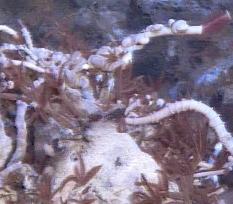
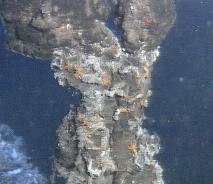 |
Septemer 14
Keith Tamburri - Vice President DTEC. Ltd.
Partner in small business that provides electronic equipment and services for Remotely Operated Vehicles worldwide.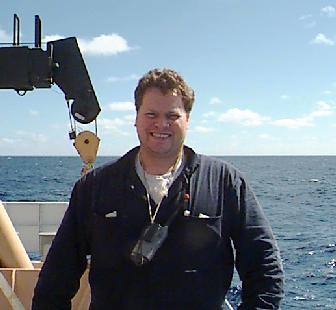
My background with ROV 's goes way back 16 years ago when I was 15 and took a weekend job to paint the floors in the shop that built ROPOS, International Submarine Engineering. From that weekend, aside from a few other small jobs, I've been in the ROV business. I attended a technical college a few years after graduating high-school and received a diploma in Robotics and Automation. My career has varied from designing complete ROV systems in the office to the operational management and supervision of these systems off-shore, both commercial and scientific. I've been the night shift supervisor for the ROPOS system for 5 years and have enjoyed this position with the ROPOS team. ROPOS, as do most ROV's , has a "personality" and must be treated in a certain way, and we seem to have synchronized over the last few years. The last two scientific cruises of the summer have provided scientists with a wealth of data, samples and video never provided before by a ROPOS cruise. With the system refinements over the years to the sub-sea navigation, cage and vehicle systems, the ROPOS platform has proven itself as a viable scientific tool.
Coming from the commercial ROV offshore world to work with the scientific ROV offshore world has been a welcome change from driving kilometers of sub-sea fibre optic telephone cable or pipeline to discovering new species of clams, crabs, worms, etc.. The operational management differences between commercial and scientific ROV cruises are quite different due to the specific nature of the dives on a scientific cruise. Each dive is planned with a certain amount of equipment on the ROV and when all the tasks of that dive have been accomplished, the ROV is recovered and re-configured for the next dive. During this period maintenance to the ROV can also be performed. In comparison, when working on a commercial job the ROV is recovered only to perform maintenance, re-rig equipment, or when the job is completed and you can go home. This cruise in particular has proven the diversity of ROPOS as seen though the pages of this web site.
Working night-shift has its benefits. Usually the room will clear out, with the exception of the scheduled watch workers and scientists who have tasks to be performed on the dive . Some of the scientists work the day-shift and on into the night shift. The room can become full of laughter quite easily as the midnight giggles set in. It's very easy to be a comedian on the night shift. After the laughter period subsides, the silence and calm of the early morning set in. Some actually start "head-bobbing" in the chief scientist's chair, only to be awakened by the cry of "PHOTO!!!" from the pilot.
Septemer 13
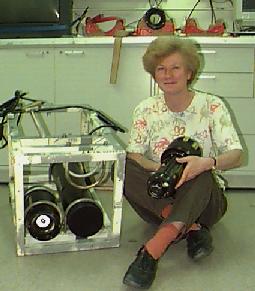
Verena Tunnicliffe
Professor,
University of Victoria
ERUPTION ALERT!! Hi, I'm a marine biologist - my name is
Verena Tunnicliffe.
(Photo show Dr. Tunnicliffe with her time-lapse camera. When deployed on the seafloor, the camera will take one photo/day of the same region to monitor change.)
Last month, I had the opportunity to visit Rabaul in Papua New Guinea. In 1994,
the city was destroyed as two volcanoes erupted. The seismologists were able to
warn the inhabitants who were able to evacuate in time; most people have now
moved away. As I look at the new lavas on Axial Volcano, I remember the huge
fields of tubeworms we saw here last year. Then, we sat our sub in the middle
of the field and the tubeworms (called vestimentiferans) towered above us -
nearly 2 meters tall! Hundreds of thousands of worm lives were lost here. They
had no warning....and even if they did, they are attached to the rocks, and
cannot move. Why would anything choose to live in such a precarious place??
(photo below left shows "baby" tubeworms on the edge of the new lava flow)
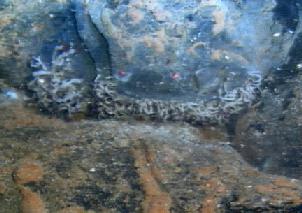
It's the food source that brings them. You have heard from our microbiologists describing the abundant microbes here. Chemical reactions in the vent fluid feeds their growth and the big animals eat the bacteria. It is a very hard place to live for many reasons: the heavy metals, the sulphide poisons, the isolation and, not the least, eruptions and extinction. Since I have worked on Juan de Fuca Ridge - 16 years now - nearly every animal we have found is a species biologists have not seen before. There are over 400 new species at vents around the world. On this ridge, we have found about 75 new species from big worms to tiny copepods. And we have a couple more from this cruise!!
An example is the tubeworm that we first found here on Axial in 1983. The
expert in the Smithsonian named it Ridgeia piscesae - "the ridge worm of
Pisces". Pisces was the name of the Canadian submersible we were using. The
vent tubeworms belong to a group of animals you won't find often anywhere else.
They shocked biologists when first discovered....they have no mouth, no gut no
anus. Just a giant sausage in a tube with a red tuft sticking out the top.
Well that sausage turns out to be a highly evolved adaptation to vents: it is
filled with red blood and bacteria. Why bother slurping up bacteria for food
when you can just grow them inside you? The worms pick up oxygen, dissolved
sulphide, and carbon dioxide with their gills. These compounds travel in the
blood to the bacteria who use energy from the oxidation of sulphide to fix the
carbon dioxide into scrumptious sugars. The sugars pass to the worm ... how
efficient!
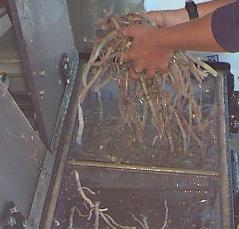
But what about all those dead worms buried under the lavas? Not all are gone: we found some sticking out the edges. When we picked up some to examine (see photo right of samples being removed from ROPOS), we found they are full of eggs and sperm - in the face of disaster, life goes on!!! One of the projects I am doing out here is to find out how quickly the new vents are colonized. And eight months later, it has already happened. Different vents have different animals, which surprises me (different chemistry maybe??). But we did find new tubeworms recruiting to the lavas. The males fertilize the females who release tiny embryos into the water. These turn into larvae that are carried by the currents for many days. Those babies are now landing on the lavas. We plan to try to bring a few live tubeworms back to Victoria where we will keep them in special conditions and see if we can make babies there to watch how they grow.
So we have some very special animals who have evolved to live on the edge: the constant threat of death but the continual chance for rebirth.
It is a great challenge to try to do this type of work out here. But so rewarding. I am a Professor in Earth/Ocean Sciences and in Biology at University of Victoria. Over the years, my program has evolved to work with interdisciplinary groups such as this one. But not only is there great pleasure in working with other scientists, the technologists and pilots of the ROPOS group have also taught me and my students a great deal - we delight in their successes. And a final note: a big hug for my little girl, Arielle, who started back to school last week; it's hard not to be there.
September 12
Julie Huber
Graduate Student,
University of Washington
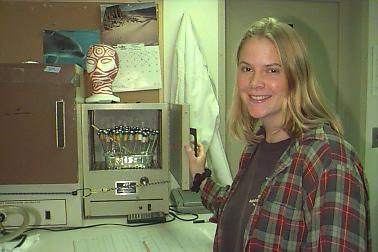
As a first year graduate student at the University of Washington, this expedition aboard the RH Brown is all new to me! I just moved to Seattle a couple of months ago from Florida, so the great Northwest is a big change for me, especially since my previous research took place in the clear warm waters of the Bahamas. Believe me, doing research from a 15 foot Boston Whaler where you can hop out any time to take a swim is a lot different from oceanographic research in the mighty Pacific over an active volcano! So far, though, I have no complaints and am overwhelmed with the abilities of the scientists, crew, and ROPOS technicians aboard. Exploring the bottom of the sea is no easy task, and I am constantly impressed with what we manage to accomplish. I do miss being able to walk in a straight line for more than 50 feet without running into a staircase, crane, or even the ocean, but I'm willing to make some sacrifices for this great opportunity.
Along with Jon Kaye, I am studying the microbiology of the hydrothermal vent systems at Axial. Although the vent environment is a grueling one, with high temperatures, pressures, and concentrations of metals and gases, microbes thrive in places like this. I am looking at the microbial community in diffuse flow sites. While you may have heard a lot about the giant smokers, not much is known about diffuse flow, which is much cooler than smoker chimneys, ranging in temperature from 3-50 degrees C. Where there are cracks in the basalt sea floor due to hydrothermal activity, we usually find diffuse flow. I am trying to figure out the basics, like what kinds of microbes live in diffuse flow? Where are they coming from- the subsurface seafloor or simply from surrounding seawater? How does the community composition change over time, especially related to the chemistry of the flow? By nature, oceanography is an interdisciplinary science, so I am trying to incorporate chemistry and geology with my biological research. Besides culturing microbes in the laboratory under various conditions, I'll also be using some molecular biology to examine the microbial population of the diffuse flow community. This method involves collecting environmental DNA from a sample, vent fluid in this case, and concentrating the microbes from that sample onto a filter. I can then extract the DNA, and use a portion of this material to determine the microbial community composition. It's a pretty handy tool, and I can't wait to see what I find!
Septemer 11
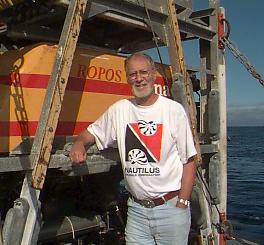
Steve Scott
University of Toronto
ROPOS was slowly navigating over the rugged basalt in the caldera of Axial
Seamount when suddenly out of the gloom appeared a huge structure that looked
for all the world like a castle from a fairy tale, complete with spires and
battlements. The Castle (photos left & right), as we now call it, is a metallic sulfide spire that is
 being formed by the precipitation of minerals from hydrothermal ("hot water")
fluid. It is about 10 meters (33 feet) high, 3 meters (10 feet) in diameter at
its base but flairs out to 5 meters (17 feet) at its top. Festoons of 50-cm to
one-meter tall chimneys that look like small minarets occur around the peak
giving the castle-like appearance. As an ore deposits geologist, this is what I
had come to Axial Seamount to see and sample.
being formed by the precipitation of minerals from hydrothermal ("hot water")
fluid. It is about 10 meters (33 feet) high, 3 meters (10 feet) in diameter at
its base but flairs out to 5 meters (17 feet) at its top. Festoons of 50-cm to
one-meter tall chimneys that look like small minarets occur around the peak
giving the castle-like appearance. As an ore deposits geologist, this is what I
had come to Axial Seamount to see and sample.
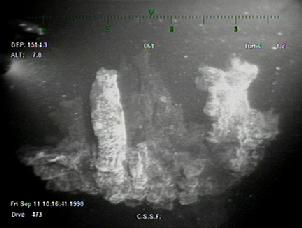 My name is Steve Scott. I am a geologist from Toronto, the
Canadian city of
back-to-back World Series baseball championships a few years ago and charging
for a wild card berth this year. In the early part of my career, I studied base
metal (you know -- copper, zinc, lead) and precious metal (silver, gold) ores on
land in Canada, the United States, Mexico, Europe, South Africa, Brazil and
Japan. For the past 18 years (ok, so I am a little older than most of the
scientists onboard), my students and I in the Scotiabank Marine Geology Research
Lab at the University of Toronto have been applying our knowledge of ore
deposits to the sea floor. We know that some types of ores that we are now
mining on land formed in oceans millions to even billions of years ago. We view
a site like Axial Seamount to be a natural laboratory for learning how such ores
are made. There are dozens of questions seeking answers. Where do the
hydrothermal fluids come from? What is their composition? How are the minerals
precipitated? Why do metallic deposits occur in some places but not others? What
is the composition of these deposits? Why is the composition different in
different geological settings? If we are successful in our research, we will
help develop new ideas for finding ore bodies on land. Some of the seafloor
discoveries may even become economic resources in the future.
My name is Steve Scott. I am a geologist from Toronto, the
Canadian city of
back-to-back World Series baseball championships a few years ago and charging
for a wild card berth this year. In the early part of my career, I studied base
metal (you know -- copper, zinc, lead) and precious metal (silver, gold) ores on
land in Canada, the United States, Mexico, Europe, South Africa, Brazil and
Japan. For the past 18 years (ok, so I am a little older than most of the
scientists onboard), my students and I in the Scotiabank Marine Geology Research
Lab at the University of Toronto have been applying our knowledge of ore
deposits to the sea floor. We know that some types of ores that we are now
mining on land formed in oceans millions to even billions of years ago. We view
a site like Axial Seamount to be a natural laboratory for learning how such ores
are made. There are dozens of questions seeking answers. Where do the
hydrothermal fluids come from? What is their composition? How are the minerals
precipitated? Why do metallic deposits occur in some places but not others? What
is the composition of these deposits? Why is the composition different in
different geological settings? If we are successful in our research, we will
help develop new ideas for finding ore bodies on land. Some of the seafloor
discoveries may even become economic resources in the future.
Mineral deposits of metallic sulfides, iron oxides, calcium and barium sulfates, silica and traces of gold are presently forming at many places on the ocean floor. The gold in samples analyzed from Axial Seamount average about 6 parts per million parts of rock by weight (ppm) -- not much but this is several times greater than the concentration of gold found as a by-product in base metals mines on land. The minerals are precipitated from heated seawater as it vents onto the sea floor. The process is a gigantic convection system. Cold (2 degrees C) bottom water percolates down faults several kilometers into the ocean crust where it is heated by magma, undergoes various chemical transformations, leaches metals from the lavas and, being hot so very buoyant, rushes back to the sea floor with its dissolved mineral load. The most dramatic product of this process is large spires, like Castle, spouting dark mineral-laden fluid from chimney-like structures at temperatures hot enough to melt lead and mixing turbulently with the ambient sea water. Castle is a dying system so the temperature of its hottest fluid is a little lower, around 270 degrees C.
Many such structures may be found in a given vent field. The hottest hydrothermal fluid of these "black smokers", so-called because they look like dirty industrial smoke stacks, is vented at several cm per second, has temperatures typically as high as 350 degrees C, and contains about 100 ppm of dissolved metals. A particularly robust black smoker can produce 500 tons of precipitates per year although most of this is lost into the overlying seawater as a particulate plume. Through time, the hydrothermal activity dies, as appears to be happening at Castle. The spires and chimneys collapse to build up a mound of rubble and new spires and chimneys grow repeating the cycle over and over. Eventually, a very large deposit is formed, such as one on the Mid-Atlantic Ridge that is the size of the Toronto Skydome ... or Houston Astrodome if you prefer.
The sea floor deposits may, themselves, be resources for the future both for their contained metals and perhaps also for their thermal energy -- a large black smoker has the same power output as a small nuclear reactor. Some seafloor deposits, although not those at Axial, are of sufficient size and apparent grade that, if they were on land, would attract the interest of the mining industry. In fact, an Australian company, Nautilus Minerals Corporation, holds the world's first exploration license for a marine metallic sulfide site that I had a hand in discovering in 1993 offshore Papua New Guinea in the western Pacific. Ocean mining of metallic sulfides will inevitably follow oil production into the deep ocean. We marine scientists are in the forefront of establishing environmental guidelines for this activity.
All of this new, almost futuristic, activity should not surprise us. After all, in 1870, Captain Nemo in Jules Verne's classic book Twenty Thousand Leagues Under the Sea said (translated from the original French): "On the ocean floor there are mines of copper, lead, silver and gold that would be easy to exploit". Maybe there is something to be learned from science fiction.
Want to know more? Send me a message via this web site (oar.pmel.vents.webmaster@noaa.gov) . Thanks for tuning in.
Septemer 10
Craig Moyer
Western Washington University
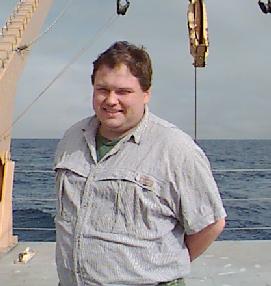
Good Day and welcome to NeMO98!
My name is Craig Moyer. I am an assistant professor at Western Washington University, where I am a member of the biology department. My specialty is molecular microbial ecology of hydrothermal vent habitats. You may wonder what exactly is it that a molecular microbial ecologist does (I know I do . . . often). Well, because many prokaryotes (bacteria and archaea) look alike, I use bio-molecules like ribosomal DNA as name tags to help identify the different kinds of microbes that like to live at hydrothermal vents like the ones here at Axial Volcano. These bio-molecules not only work just like the bar codes that get scanned at the grocery store, but they also store information regarding who is most related to whom. Therefore, my job is basically that of a microbe census-taker and genealogist. In addition, I try to understand how the structure of different microbial communities relates to the different types of chemistry we see at the vents. If that weren't enough, I also attempt to keep track of how these microbial communities change across space (across a single vent, from one end of the vent site to the other, or even from one geographical region to another) and over time (from days to months to years).
Hydrothermal vents are a great place to study the structure and diversity of microbes because many scientists now think that these habitats are where life began almost 4 billion years ago. This means that studying vent microbes is like looking at organisms that have been around for a long time and therefore have been very successful; like studying the Coelacanth if you are interested in fish. Since hydrothermal vents are considered extreme environments, this tends to keep the overall numbers of different types of microbes lower in any single habitat or location than what you would find someplace more mild like forest soil, which has on the order of 10,000 to 100,000 different kinds of microbes per gram! This makes my job a little easier.
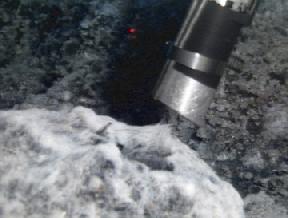 In order to sample the microbial communities, myself and grad student Karen
Pelletreau employ a couple of different approaches. First, we use an underwater
device attached to ROPOS called the
"slurp-gun" (photo right) to vacuum
up microbial mats and capture them in sample jars. Second, we use
"bacteria
traps" (photo below left) which we leave in place for a set amount of time,
allowing the colonization of microbes as the vent effluent passes through a
cylinder covered with a fine mesh with glass wool inside. The bacteria are what
we call substrate-limited, so we give them a place (in this case glass wool made
of inert silica as a substrate) to attach as the hot vent water passes through.
The mesh is to keep the bigger animals like
palm worms and scale worms from
eating all of our samples.
Basically, we provide the microbes with a refuge and
happy place to grow. Upon recovery of these samples, we then preserve them in
liquid nitrogen, for example, for later molecular biological analysis.
In order to sample the microbial communities, myself and grad student Karen
Pelletreau employ a couple of different approaches. First, we use an underwater
device attached to ROPOS called the
"slurp-gun" (photo right) to vacuum
up microbial mats and capture them in sample jars. Second, we use
"bacteria
traps" (photo below left) which we leave in place for a set amount of time,
allowing the colonization of microbes as the vent effluent passes through a
cylinder covered with a fine mesh with glass wool inside. The bacteria are what
we call substrate-limited, so we give them a place (in this case glass wool made
of inert silica as a substrate) to attach as the hot vent water passes through.
The mesh is to keep the bigger animals like
palm worms and scale worms from
eating all of our samples.
Basically, we provide the microbes with a refuge and
happy place to grow. Upon recovery of these samples, we then preserve them in
liquid nitrogen, for example, for later molecular biological analysis.
In addition to studying microbial communities, I am also interested in "culturing" as we microbiologists call it, the more significant members from within the community. This means trying to get the individual types of microbes which are the "major players" to grow in the laboratory. This isn't always an easy task, as many if not most microbes have been found to be unculturable. That doesn't stop us from trying new ways to make them happy. Together with my colleague David Emerson at the American Type Culture Collection, we discovered a novel way to "culture" a new kind of iron-oxidizing bacteria that is able to live completely off the energy from the oxidation of iron (similar to the formation of rust) without requiring a lot of acid around to do it. We have found that this type of bacteria is a major component in many hydrothermal vent systems, and hope to find it here at Axial Volcano as well.
I've been studying the diversity and structure of microbial communities for nearly 8 years now with much of my work happening at places like Loihi, an undersea volcano in Hawaii, or the Guaymas Basin in Mexico. I have been a part of many dive programs with over 75 dives using submersibles and tethered-vehicles, and during this time I have not seen such an amazingly productive tool as ROPOS. It is truly an undersea platform for the future. As I'm sure you an tell from looking at the series of homepages from the NeMO 98 expedition to Axial Volcano, there are many scientists out here with many different projects and interests, and ROPOS has come through like a champ allowing us all to have a wonderful window into the hydrothermal world below. Kudos to the ROPOS team and the captain and crew of the NOAA ship Ron Brown!
Septemer 9
Geoff Wheat
University of Alaska, Fairbanks
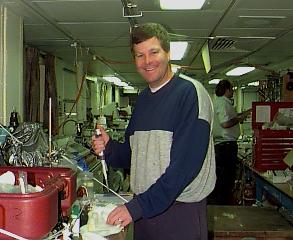
Howdy,
My name is Geoff Wheat. I am a faculty member at the University of Alaska Fairbanks, but unlike most faculty I do not teach. Instead, my duties are to conduct research and to help administer the West Coast and Polar Regions Undersea Research Center.
My research interests focus on the study of seawater circulation through the
oceanic crust, which is similar to the study of groundwater flow through
continental crust. In particular I study the effects of this circulation on the
evolution of the crust and how this circulation concentrates metals to form
deposits. I have studied the effects of seawater circulation within the oceanic
crust along a continuum of geologic settings from new crust on mid-ocean ridge
axes to old crust at subduction zones. By far the most spectacular product of
seawater circulation through the ocean crust is hot springs (>300 degrees C),
such as the ones that are the focus of the NeMO Cruise.
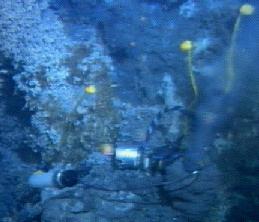
My particular focus for this cruise is to understand how this hydrothermal
system evolves. Fresh magma erupted at this site during the February 1998
seismic event. The heat from this magma drives seawater circulation and
produces hot springs. This circulation also cools the magma, resulting in a
decrease in the rate of flow with time. During this cooling it is inevitable
that changes occur in the physical and geological conditions though which the
seawater flows. This change is then reflected in the chemical and thermal
composition of the hydrothermal fluid. To understand these changes a colleague
of mine (
Hans Jannasch at the
Monterey Bay Aquarium Research Institute) and I
have developed a long-term continuous water sampler ("osmometer" pictured left and below right). This sampler is designed
to collect a sample three times a week for an entire year. We are deploying two
of these samplers this year to be retrieved and analyzed next year.
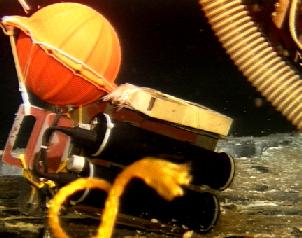
My administrative duties are to promote, fund, and facilitate undersea research through the West Coast and Polar Regions Undersea Research Center (the Center). This Center is one of six centers in the National Undersea Research Program, which is funded by the National Oceanic and Atmospheric Administration (NOAA).
Each year the Center advertises a call for proposals. Academic and government researchers submit proposals that require the use of undersea assets (submersibles, remotely operated vehicles, autonomous underwater vehicles, and SCUBA diving) to solve a particular problem. These proposals are reviewed by scientists with similar backgrounds. The reviews are given to a panel of scientists who then rank all of the proposals. Problems that are addressed by these proposals are very diverse and range from questions concerning fisheries habitat and effectiveness of harvest refugee to the characteristics of faulting along the Oregon and Washington margins and the relationship between this faulting and earthquake potential. The best proposals, such as the one submitted by Bob Embley and Bill Chadwick for a portion of the work that we are now conducting, are then funded by the Center. As a representative for the Center I observe the progress of new technologies and undersea vehicles so that I can inform other scientists who may need undersea tools and vehicles to solve scientific questions related to the sea.
Septemer 8
Mike Stapp
NOAA PMEL Engineering Development Division, Seattle
Mike Stapp
NOAA PMEL,
Engineering Division
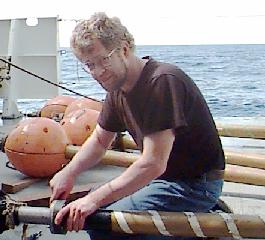 Hello from the NOAA ship Brown. My name is Mike Stapp and I am an electronics
engineer at the
Pacific Marine Environmental Laboratory in Seattle. My primary
duty on this cruise is to repair the electronics in scientific instruments that
fail. I have been spending most of my time helping
Dave Butterfield get his
fluid sampler working. Since it is a new instrument, there were a few bugs that
didn't show themselves until we attempted to run it at sea. We were lucky enough
to be able to have the
Air Force drop off a new circuit board when a chip failed
at sea. It is always a challenge to repair electronics at sea where you always
seem to be missing the one crucial spare component or circuit diagram. We were
able to find a substitute sample pump in another instrument on board when one of
the fluid sampler's pumps started operating intermittently. The fluid sampler
is operating well now, which should make quite a few scientists on the Brown
happy!
Hello from the NOAA ship Brown. My name is Mike Stapp and I am an electronics
engineer at the
Pacific Marine Environmental Laboratory in Seattle. My primary
duty on this cruise is to repair the electronics in scientific instruments that
fail. I have been spending most of my time helping
Dave Butterfield get his
fluid sampler working. Since it is a new instrument, there were a few bugs that
didn't show themselves until we attempted to run it at sea. We were lucky enough
to be able to have the
Air Force drop off a new circuit board when a chip failed
at sea. It is always a challenge to repair electronics at sea where you always
seem to be missing the one crucial spare component or circuit diagram. We were
able to find a substitute sample pump in another instrument on board when one of
the fluid sampler's pumps started operating intermittently. The fluid sampler
is operating well now, which should make quite a few scientists on the Brown
happy!
I am also helping Gary Massoth with the SUAVE (Gary named it, not me!) chemical sampler whose software and electronics I designed . Gary has been using the SUAVE very successfully for several years now but there has always been a problem with the valve used to switch in the standards for calibration. We are using a new valve on this cruise which looks like it will work more reliably and ease Gary's data analysis.
I will also be helping Bill Chadwick with recovering and re-deploying the acoustic extensometers (see above science report) whose software and electronics I designed . These 5 instruments were deployed 2 years ago and the plan is to use ROPOS to recover them from the sea floor, retrieve the data, and then re-deploy them with new batteries. These instruments are designed to operate for 1 year so it will be interesting to see how long they last beyond that. When I get back to PMEL I will be continuing work on a new extensometer designed to last 5 years on the sea floor. Besides having more batteries than the current version, it will have an acoustic modem so a ship can stop by every year and retrieve the data without having to recover the instrument from the bottom. I should have had the design finished before this cruise but it seems that electronics and software design never go as quickly as one would like!
September 7
Dave Butterfield
NOAA Vents Program, Seattle
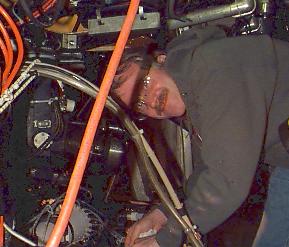
|
Dave fitting the fluid sampler to ROPOS after successfully installing the parts delivered from the Air Force. |
A major component of our work during this NEMO98 cruise is to investigate the interconnections between volcanic processes, the chemistry of hydrothermal fluids, and the nature of the micro-organisms and animals living in the vent environment. In order to do this, we have to collect hydrothermal fluid samples. It probably seems strange to go to great lengths to collect hot water from the bottom of the ocean, but fluid chemistry is like our sense of smell, and it tells us what is cooking below the seafloor where water reacts with hot rock, and hyperthermophilic microbes grow. Never mind that the vent fluids smell like rotten eggs.
The technology we use to collect water samples with remotely operated vehicles has evolved over the last 5 years. In 1993, we adapted the titanium water samplers used since the late 1970's on Alvin and other manned submersibles for use on the ROPOS ROV. This was extremely inefficient, and I vowed not to do vent fluid sampling again with an ROV until I could come up with a more effective technology. The West Coast National Undersea Research Center provided funding to PMEL to build a sampler to take 7 titanium samples per dive, and this sampler, called MS95 for short, was completed and used in 1996. Titanium is used because it is very strong and very resistant to corrosion, so that it doesn't contaminate the vent fluid samples. The finished sampler outfitted with 7 titanium samplers, each with an electrical actuator in a titanium housing, connected by titanium tubing and fittings, was a beautiful thing to behold for anyone who appreciates metals.
Oceanography is sometimes a risky business, as is any undertaking at sea. During the maiden voyage of the fluid sampler, it was lost with ROPOS during a severe storm. I'll never forget watching the tether sever and seeing ROPOS disappear along with the new fluid sampler. The original ROPOS and the fluid sampler have not been seen since that stormy night.
After regrouping, I decided it was definitely worth trying again to make a fluid sampling tool for ROV's. This time, however, the sampler would have to be simpler, lighter, more versatile, and less expensive. With financial support from Dave Epp of the National Science Foundation, and with the engineering support at PMEL, I settled on the concept of pumping vent fluid through a system of tubing with a flushing pump, then pulling the fluid with a second pump into individual containers selected by a multi-port valve. The system would require only electrical power and data communication from the ROV, with no requirements for hydraulics, and relatively few cables, so that it could be adapted to different vehicles. McLane Research Labs of East Falmouth, Massachusetts, built the multi-port valve and the pumps, and PMEL engineers designed the mechanical and electronic aspects. The new sampler was completed just in time for testing and use during this cruise.
After working hard on this project for months, it was finally ready to be used on a dive. But, there were a few more obstacles to overcome. A simple error just before the planned dive resulted in a blown component for which there was no spare. When you are 300 miles out to sea, and you don't have a spare part, you can't just get out your credit card and ask for overnight delivery. We were stuck.
After considering the options, giving up was not among them. I contacted McLane
on the weekend, and they got to work putting together the spare components
needed for the fluid sampler. Resourceful colleagues at PMEL reached out to
find a way to get the parts to the ship. I was expecting perhaps a chartered
fishing boat to come out and meet the ship with the parts, but what we got
instead was a special air drop from an Air Force C141 jet on a training mission
out of McCord Air Force Base. "Operation Buffalo Chip" last Thursday afternoon
was a big success.
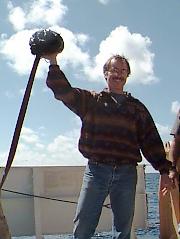 Many photos were taken as the Air Force C141 jet made 3
passes at low altitude, with a flawless parachute drop and pickup.
Many photos were taken as the Air Force C141 jet made 3
passes at low altitude, with a flawless parachute drop and pickup.
After receiving the replacement boards from McLane via Operation Buffalo Chip, Mike Stapp and I installed and tested the new boards. This fixed the problem of the valve not working. We thought everything was fine, but we discovered with further testing that the sample pump had developed a problem. It would sometimes start, but most often would not, and the only thing that could get it started again was to physically rotate it back and forth about its axis. We were stuck again Thursday night.
However, luck continued to be with us on this project. We had on board another McLane that had been recovered during the previous leg after a year-long deployment. The sample pump on this system is exactly the same size and has the same connector as the newer pump. Mike checked it out, and plugged it into the fluid sampler, and it worked perfectly! We were back in business. Within 6 hours of this discovery, we had the sampler rigged for deployment early Saturday morning. We had to wait out some bad weather, but the sampler went on dive 468 Saturday night. We collected one sample successfully, but then the robot arm developed a problem and could not be moved without swinging wildly. We were able to take 4 more samples before the dive had to be aborted.
We turned the system around overnight and redeployed it on Dive 469 yesterday morning. This time around, the sampler and ROPOS worked perfectly. During approximately 12 hours of dive 469, we took 6 piston samples, plus 8 collapsible bag samples and 3 microbiology filters to collect particulate material only. We also collected two titanium gas-tight samples on this same dive, making it by far the most productive fluid sampling dive ever for an ROV. The samples came up at midnight and we processed them overnight. After using the new Hot Fluid Sampler, I'm very impressed with the results. It's an excellent system for collecting the slow-flowing vent fluids that carry the unique heat-loving microbes out of the seafloor. I'm looking forward to using it again soon to learn more about how the fluids on Axial Volcano are evolving after the eruption last January. After the non-stop action of the last 3 days, however, I'm looking forward to a few hours of sleep even more.
Thanks to everybody who helped.
Dave Butterfield
Septemer 6
Captain Dave Peterson
NOAA Ship Ronald Brown

Greetings from the Bridge of the RONALD H BROWN!
I'm Captain Dave Peterson, of the NOAA Commissioned Corps, and I am the first Commanding Officer of this fine new ship...an honor that last occurred to a NOAA Corps officer some 18 years ago. RONALD H BROWN is NOAA's first new ship in almost two decades...replacing two proud ships, DISCOVERER and MALCOLM BALDRIGE, whose accomplishments over their long and distinguished careers give this ship worthy goals to emulate.
Almost half of my NOAA Corps career has been at sea, serving on both research ships and survey ships. This is my second opportunity to serve as captain of a NOAA ship. I can say, simply and without overstatement, that command-at-sea has been, and still is, the most challenging and exciting aspect of my 25 years of service.
So, just what does the captain of NOAA's largest blue-water research ship do? My touchstones as captain are three: Safety, Mission, and Service. The safety of this ship, and the lives of all aboard, are the inescapable responsibility of the captain. Safety is a two-syllable word that, on a ship, has a two page definition. As captain, I try to ensure that "safety first" is more than just a slogan. RONALD H BROWN is a safe ship, as all who have sailed aboard it can truthfully attest.
This ship, like all NOAA ships, exists for only one reason...to serve the needs of NOAA programs, like VENTS, by providing reliable, cost-efficient, capable platforms for their oceangoing missions. On cruises, I work with the Chief Scientist, on this particular cruise, Dr. Bob Embley, to carry out the ship's research mission. The orders for each cruise, called Cruise Instructions, are issued to both the Chief Scientist and the Commanding Officer. We each have different roles to play in achieving the assigned objectives of the mission. My role is to correctly apply all the resources and capabilities of this ship to support the requirements of the science program. It often becomes a balancing act and takes equal measures of coordination and diplomacy so that all needs are met...both scientifically and operationally. It helps to see the other guy's problems and to be able to explain yours to him, so a good working relationship is really important. Bob Embley is an old hand, and an effective Chief Scientist. VENTS will have a successful cruise on BROWN this year.
The third touchstone is service...and it's really built on the other two. This ship, its crew, and its missions serve the American taxpayers. We are, collectively, instruments of NOAA's vital national role for environmental stewardship. It is my job to look at the larger picture and make sure that RONALD H BROWN makes an effective contribution to that national role. If we aren't safe, and aren't focussed on mission success, then we aren't serving anyone's interests. I take pride in the way BROWN has performed through its first two seasons. The taxpayers are getting their money's worth...and me, well, I'm having fun!
Septemer 5
Matthew Ofsthus
Chief Boatswain, RON BROWN
 |
Chief Boatswain, Matt Ofsthus, with the package dropped by the Air Force |
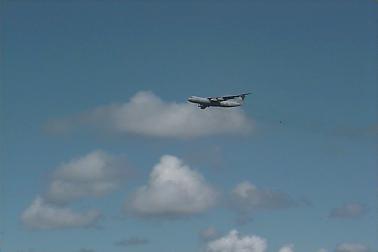
Today was a good day to write about because at about 1 pm we had a little visitor, well maybe not so little. We had a special delivery from the Air Force. Dave Butterfield was in need of a critical piece of electronics for the instrument he is using, so a call was placed to the beach a few days ago trying to find someone who would make a little detour to the ship, well it turns out the Air Force came through, dropping by parachute, the part that was critical to make Dave's equipment work.
Some of the instruments I have seen to support Vents have been interesting to say the least. That is why I enjoy the Vents Program the most of any projects I have worked with. There is always something different. The most interesting would be the ROPOS sub and the "cage" that holds it. Imagine something that is tall as a single story house, is as wide as a car, and weighs as much as four 1965 Buick Riviera's!!
Septemer 4
John Chadwick
Graduate Student,
University of Florida
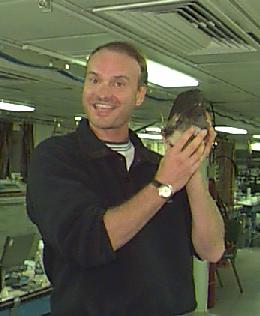
Once upon a time there was a geologist named John Chadwick, who spent a month on a big ship called the Ronald Brown. John was handsome, smart, honest, hard-working, resourceful, and very, very modest. One day our hero was taking samples of the sea floor using a heavy, torpedo-shaped device that collects tiny pieces of glassy rock that form when hot basaltic lava is quenched by the cold ocean water. The chemistry of this glass holds important clues to the origin and evolution of the lava that has erupted from Axial volcano and other related volcanoes on the rifted zone to the south of Axial. The torpedo device is sent down to the ocean floor, sometimes more than a mile down, on a long steel cable.
Well on one particular day, instead of tiny slivers of rock that weigh less
than a typical dust bunny, the cable had tangled itself around a rock the size
of a small house. OK, maybe I'm exaggerating a little, it would have to be a
VERY small house. The rock was in fact about three feet long and weighed in at
about 100 pounds! That's about one-quarter the weight and size of those really
big-boned people you see at the mall! Everyone on the ship was so excited about
the big rock that someone was actually overheard saying, "Look. A rock."
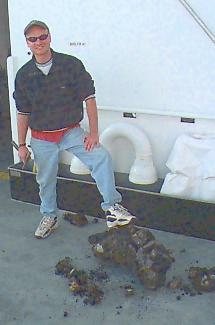
The geology of the Axial volcano area is actually very interesting, because
the volcano lies at the intersection of a
mid-ocean ridge and a chain of hotspot
volcanic islands. Mid-ocean ridges are places where new oceanic crust is
forming by volcanic processes, and are interconnected around the Earth like the
seams on a baseball. Hotspots are where hot plumes of magma from deep in the
Earth's mantle come to the surface, creating chains of volcanoes like the
Hawaiian Islands. These two volcanic processes are overlapping here at Axial
volcano, a situation that is very similar to Iceland. All of these processes
are driven by heat coming from within the Earth, heat created by the
decay of
radioactive elements and heat leftover from the Earth's formation 4.6 billion
years ago. All this volcanism is just the result of the Earth cooling itself
off and releasing heat, very similar to the hot air that politicians
release
during a speech. The interesting things that some of the other scientists on
the Brown are studying, like the hydrothermal vents and the strange creatures
that form around them on the ocean floor, all owe their existence to
these
underlying thermal and geologic forces that have created Axial volcano.

Our hero will continue to doggedly pursue his tiny pieces of rock, and the occasional boulder. He will study their chemistry upon his return to the University of Florida and try to unravel some of the mysteries of this interesting volcano. He is thoroughly enjoying the experiences aboard the ship, his first ever voyage to explore the geology under the sea. The sunsets and sunrises out in the Pacific are some of the most vivid and dramatic he has ever seen. The sun, clouds, and sea perform a mystical alchemy that cannot be matched on land. Dark blue waves and shimmering white clouds march by the ship like powerful legions in arms heading for a distant war. The ship is about the size of a typical hotel, so you'd think that claustrophobia might be a problem (The ship is in fact quite large (our hero still hasn't found the Men's bathroom.) Thank goodness for the Poop Deck!)). But outside, you can see 360 degrees of horizon, so one might also experience, well, whatever the opposite of claustrophobia is. Big-outside-phobia is the technical term, I believe.
Septemer 3
Kim Juniper
University of Quebec
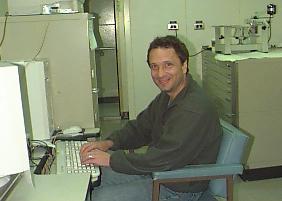
WHO IS THIS GUY?
This guy is Kim Juniper, a professor in the GEOTOP Research Centre at the University of Quebec in Montreal, Canada. Together with my friends and colleagues Steve Scott and Verena Tunnicliffe, who are also out here at Axial Volcano, I am celebrating my 15th year of hydrothermal vent research. We are at the spot where it all began in August 1983 when we made the first discovery of deep sea vents in the North Pacific Ocean using the manned submersible Pisces IV. That was the summer that I got hooked on hot vents. Just a few months before I had finished a PhD in New Zealand and moved back to Canada for a two year fellowship at the Institute of Ocean Sciences in Sidney, British Columbia. There I was using the Pisces IV submersible to study bacterial growth in an local fjord. One thing led to another and I found myself with a last minute invitation to join the CASM (Canadian-American SeaMount) expedition to look for hot vents on the Juan de Fuca Ridge. We were lucky enough to find what we were after and I've been doing this ever since.
I have a hard time categorizing what kind of research I do because I'm interested in many things and don't pay too much attention to traditional boundaries between different branches of science. I was trained as a marine microbial ecologist, someone who studies the ecology of bacteria and other microorganisms in the marine environment. However, I don't usually get too excited about studying just bacteria.
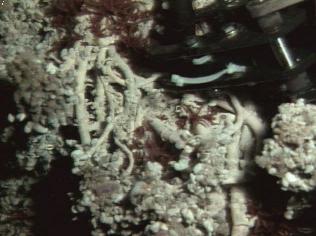 BACTERIA AS MENU ITEMS
BACTERIA AS MENU ITEMS
RUSTY FLUFF
Another one of my favorite areas of research is to look at how microbes interact
with minerals. Hydrothermal vents are very important areas for the formation of
mineral deposits. Out here at Axial Volcano I am trying to understand how 'iron
bacteria' help form coatings of 'rusty fluff' of iron oxide that we are seeing
everywhere on the new lavas from last winter's eruption. Iron bacteria create
energy for growth by transforming dissolved iron into rust. The rust or iron
oxide mixes with bacterial slime to form a coating on the outside of their
cells. I started studying iron bugs back in 1988, working with a French
colleague on fossil bacteria in rocks called cherts which are very rich in iron
oxide. These rocks came from mines in Cypress and the Phillipines and California
where sulfide ores formed at hot vents on the floor of ancient oceans are being
extracted for metals such as copper, lead, zinc and silver. That project got me
interested in iron bacteria but I could never find a place in today's ocean to
do more work on the subject. Then, in 1993 we used ROPOS to visit a fresh
eruption just to the north of Axial Volcano and low and behold there were 'mats'
of iron bacteria in some of the crevices on the new lava flow. We scooped up
samples to analyze and used video to map where the mats were found on the
seafloor. The analyses showed that the mats were a lot like the stuff that I had
been seeing in the fossils. Filaments of bacteria coated with an inside layer of
iron and an outside layer of silica. In the past 10 days we have been seeing
dustings of this same rusty fluff all over the new lava,
 to the point where it
was hard to tell the difference between new lavas which are usually shiny and
black, and older ones which have a coating of sediment formed by the slow
accumulation of plankton debris. I am working with the geologists and other
microbiologists on the ship to try and figure out how so much of this rusty
fluff could have formed so quickly. That means collecting samples of the stuff,
and trying to figure out where all the iron could have come from to make it.
Ideas are flowing as fast and freely as the discoveries we are making during the
dives. Just when we think we've got it nailed, we see something new and off we
go back to the drawing board. But we are getting closer to an answer, thanks in
part to the fact that we can all participate in the dives by watching the video
feed from the ROPOS cameras. Having a room full of experts in geology and
biology all looking at the same thing really cuts down on the "I wonder what
that is" time.
to the point where it
was hard to tell the difference between new lavas which are usually shiny and
black, and older ones which have a coating of sediment formed by the slow
accumulation of plankton debris. I am working with the geologists and other
microbiologists on the ship to try and figure out how so much of this rusty
fluff could have formed so quickly. That means collecting samples of the stuff,
and trying to figure out where all the iron could have come from to make it.
Ideas are flowing as fast and freely as the discoveries we are making during the
dives. Just when we think we've got it nailed, we see something new and off we
go back to the drawing board. But we are getting closer to an answer, thanks in
part to the fact that we can all participate in the dives by watching the video
feed from the ROPOS cameras. Having a room full of experts in geology and
biology all looking at the same thing really cuts down on the "I wonder what
that is" time.
Kim Juniper
Septemer 2
Kevin Roe
NOAA Vents Program, Seattle
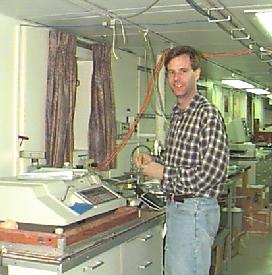
Hi! My name is Kevin Roe and I'm with NOAA/PMEL and the University of Washington. I'm working with Dr. David Butterfield, researching the chemistry of hydrothermal vent fluids.
What is a hydrothermal vent fluid? When seawater percolates through the ocean crust and encounters a heat source, such as at an ocean ridge spreading center or undersea volcano, seawater is heated and reacts with the rock. Magnesium and sulfate are removed from the fluid, and it becomes more acidic. Metals and silica are extracted from the rock and hydrogen sulfide, that rotten-egg gas is produced. If phase separation has occurred (most people call this boiling) hydrothermal fluid can be less or more salty that seawater. Hydrothermal fluid escapes the seafloor as high temperature vents, such as black smokers at up to 400 degrees C and as warm diffuse venting . We sample hydrothermal fluids with unmanned robot submarines such as ROPOS and manned submarines such as ALVIN.
My job onboard this ship is to analyze vent fluids for hydrogen sulfide, ammonia, pH, alkalinity and dissolved oxygen. All of these analyses must be done quickly as these chemical species are quickly oxidized, bubble out of solution or utilized by bacterial growth in a short period of time. I do take sub-samples back to the laboratory to analyze for the more stable chemicals such as sea salts and metals.
Dave and I sampled some of these same sites with the Deep Sea Vehicle ALVIN July 7-July 26 of this year and we are getting a more extensive "tour" of the eruption site at Axial seamount. An advantage of using an unmanned robot sub is that it can stay down longer (greater than 48 hours) and everyone who's awake can watch the progress on video monitors. It is almost like being there.
Kevin Roe
Septemer 1
Keith Sheperd
General Manager, Canadian Scientific Submersible Facility
 Watching the ocean, there are never two days when it looks the same.
Throughout
the day it is always changing. It is hard to pause and observe the waves, clouds
and life during our busy
ROPOS lives.
I have always been amazed and fascinated by the ocean floor and its diversity.
Particularly fascinating are the hydrothermal vents, and the associated biology
and geology. I have worked in these areas for over 16 years, and the
more I
learn, the more fascinating it becomes. It is a pleasure and a privilege to work
with so many researchers, who are each so dedicated and committed to
wringing
the most out of the huge amount of data ROPOS and its support team provide.
Working with these scientists helps keep the ROPOS team focused and the morale
high.
Watching the ocean, there are never two days when it looks the same.
Throughout
the day it is always changing. It is hard to pause and observe the waves, clouds
and life during our busy
ROPOS lives.
I have always been amazed and fascinated by the ocean floor and its diversity.
Particularly fascinating are the hydrothermal vents, and the associated biology
and geology. I have worked in these areas for over 16 years, and the
more I
learn, the more fascinating it becomes. It is a pleasure and a privilege to work
with so many researchers, who are each so dedicated and committed to
wringing
the most out of the huge amount of data ROPOS and its support team provide.
Working with these scientists helps keep the ROPOS team focused and the morale
high.
Ahh, the ROPOS team. I cannot say enough about the men who are committed to keeping ROPOS on the leading edge. It takes great personal and family sacrifice to spend so much time with ROPOS at sea, and many long days and weeks on shore to maintain, repair and prepare for the next mission. ROPOS would not be the unparalleled tool it is today without the hard work and dedication of these people, and support of their families. I am very lucky to be involved in such a challenging and interesting pursuit.
Keith Shepherd (chief ROPOS pilot)
August 31
Jon Kaye
Graduate Student, University of Washington

Don't be tricked by the animal biologists or rock jocks aboard the R/V Brown. Those animal folks count the number of little hairs on the little legs of little worms. Not only is that gross, but would you enjoy counting how many tiny hairs are in your nose? And the geologists end up measuring the same chemicals that make up rocks, time and time again (yawn!).
The MICRObiology is the coolest aspect of exploring the deep-sea hydrothermal-vent system. Microbes are so small that you could stack 1,000,000 of them end to end in a space of only 3 feet! But microbes are so numerous that they change the entire deep-sea environment; from how it looks to what chemicals it contains. Some of them can also do the coolest tricks; like live at temperatures of up to 115 C (that's HOTTER than boiling water, but under pressure water won't boil!). Some others will eat toxic compounds for breakfast. Indeed, hydrothermal vents are the most extreme environment on Earth, and the microbes inhabit almost every niche available.
I'm a third-year graduate student at the University of Washington in Seattle. Since I arrived there, I've been studying deep-sea hydrothermal vent microbes that can jump through every physiological hoop I threw at them. This includes culturing "bugs" (as we like to call them) at cold and hot temperatures (near the freezing and boiling points of water), exposing them to toxic chemicals like arsenic and mercury, and also testing whether some of these marine microorganisms are able to cope with wide variations in how much salt is around, from freshwater conditions to salty fluids that are 10 times saltier than the ocean. And, guess what? The different microbes that I work with are able to conquer these different stresses. It amazes me constantly. I know that no animal could ever cope with the conditions I throw routinely at hydrothermal-vent "bugs." If you want to learn some more about these extremophiles (as we call them), you can also check another website: Go to ABC News Science section, and look for the link to more details on what I'm up to during this deep-sea expedition.
Jon Kaye
August 30
Gary Massoth
Research Associate, NOAA Vents Program

Hello from the Northeast Pacific! My name is Gary Massoth and I am a Chemical Oceanographer with NOAA's Pacific Marine Environmental Laboratory in Seattle. I am a member of the Vents Program's team of interdisciplinary scientists who are trying to understand how undersea volcanoes work and, in particular, how they effect the oceans. A discovery we made in 1986 has changed the way we view how some of these effects are generated. By serendipity (we were in the right place at the right time), we then witnessed the first megaplume, a huge burp of heat and chemicals delivered to the oceans. That burp transferred sufficient heat to electrify New York City for a year, or, in terms oceanographer's use, was equivalent to the annual output of a hydrothermal vent field, only it happened over hours to days. We have since come to understand that megaplume emissions are associated with lava eruptions, and besides being an important process for the transfer of heat and mass from the interior of the earth to the oceans they provide unique glimpses into the underworkings of volcanoes. Most recently we have learned that megaplumes provide insight into the realm of the subseafloor biosphere, which you will hear about later from some of my colleagues on this expedition. So how do we get from Megaplumes to Project NeMO? We conceived this project and located it at Axial Volcano because we anticipated that Axial was ripe for a lava eruption (based on hard-earned geophysical sleuthing performed by my Vents co-investigators) and thus was a good candidate for studying megaplume-type emissions. If you have been following my shipmate's commentaries, you know that is exactly what happened, even and right before we had this, our inaugural NeMO experiment! So now we are out here doing the event response research we dreamed of and proposed.
My niche in all this as a chemist is to operate SUAVE (Submersible System Used to Assess Vented Emissions). SUAVE is a miniature chemistry lab that actually goes underwater to measure the concentrations of key chemical species (like hydrogen sulfide, which energetically drives the bulk of the microbes within the biosphere and also the vent communities) right where they vent into the ocean. Because some of these species are difficult to collect and preserve, SUAVE not only provides us with an improved view but also a broader one, as it spews a continuous stream of concentration information for wherever it's intake probe is placed during a deep-sea deployment. Four months ago, SUAVE and I were in the South Pacific between Easter Island and Tahiti prospecting for plumes from a surface ship in a region where seafloor lava eruptions may be the most common on Earth. Two weeks ago I was on ALVIN using SUAVE to measure the environment where tube worms grow. And now, I am on the NOAA Ship BROWN using SUAVE on what I think is the optimal type of deep-sea platform for it s deployment: an ROV (Remotely Operated Vehicle, here ROPOS-II, a real beauty!). Having the opportunity to explore in this way is exciting, but it is also demanding. Planning the expeditions, preparing SUAVE, and getting it and supporting chemicals and equipment to the various ships can take as much time as the expeditions themselves. I've just left a 13-hour SUAVE watch to write this, that was only half of one ROPOS dive (thankfully, I have co-worker, Stacy Maenner, who you will hear from later, to relieve me). That was preceded by a frantic 12-hour maintenance period (for SUAVE and ROPOS) and another day-long dive. And so it will go. We come home from cruises exhausted, but scientifically re-charged. In the end, the balance is strongly in favor of being a SUAVE guy. I wish you all could share the experience and hope that by reading our commentaries we can include you in spirit! Time to relieve Stacy so long!
Gary
August 29
Betsy McLaughlin-West
Researcher, Rutgers University
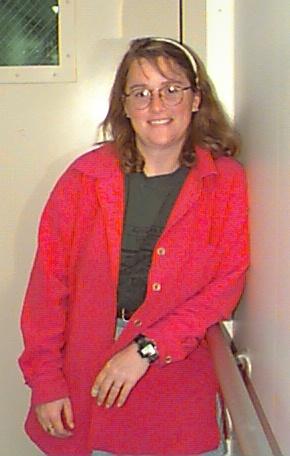 Hi all, my name is Betsy McLaughlin-West. I'm an oceanographer from
Rutgers
University. I have been studying hydrothermal vent environments for the past 7
years. My main interests are the chemistry of the hydrothermal fluids and the
bacteria that use the hydrothermal chemicals as energy sources. The hot water
that comes out of the vents contains a number of chemicals that bacteria can use
for food. The main ones I have been studying are hydrogen and methane gas.
At most vents, there is a lot more hydrogen and methane gas in the hydrothermal
fluids than in the background seawater. The bacteria that can use these energy
sources can grow better in vent environments than in other parts of the ocean
(since there is more to eat around the vents). I've been trying to determine
how important hydrogen and methane (and the bacteria that use these gases) are
to the entire vent environment and the larger animals that live there.
Hi all, my name is Betsy McLaughlin-West. I'm an oceanographer from
Rutgers
University. I have been studying hydrothermal vent environments for the past 7
years. My main interests are the chemistry of the hydrothermal fluids and the
bacteria that use the hydrothermal chemicals as energy sources. The hot water
that comes out of the vents contains a number of chemicals that bacteria can use
for food. The main ones I have been studying are hydrogen and methane gas.
At most vents, there is a lot more hydrogen and methane gas in the hydrothermal
fluids than in the background seawater. The bacteria that can use these energy
sources can grow better in vent environments than in other parts of the ocean
(since there is more to eat around the vents). I've been trying to determine
how important hydrogen and methane (and the bacteria that use these gases) are
to the entire vent environment and the larger animals that live there.
In order to figure these things out, I'm collecting two types of water samples on this cruise. We can sample the venting fluids directly with ROPOS (which I'm sure you'll hear more about in a later report so I'll leave it until then) and we can collect fluids from the water column above the vents with a system called a CTDT/Rossette. A CTDT is an instrument that can measure the conductivity, temperature, depth and the amount of particles in the water. It is connected to the ship with a conducting wire so you can actually have real-time access to the data it is collecting. It is attached a cage-like package that also has eleven 20 liter water bottles attached to it. The cage is lowered over the side of the ship with the bottles open. As it gets lowered through the water column we can decide where to close the bottles based on the data we are collecting with the CTDT. When the hot water from the vents comes out at the seafloor it is buoyant and rises in the water column. As it rises it mixes with the surrounding seawater until it is no longer buoyant and it begins to spread out in a layer and moves with the currents (sort of like smoke coming out of smokestack being blown by the wind). This is called the hydrothermal plume. Although the fluid has mixed with a lot of seawater by this times (10000 parts seawater to 1 part vent fluid!), it still has a slightly higher temperature and particle content then the seawater around it. The CTDT can measure those temperature and particle differences so we know when we are 'in the plume' and can close the water bottles. Not only does the plume have temperature and particle differences, it also still has more hydrogen and methane than normal seawater so it is a good place for the bacteria to hang out since there is food there!
I'm hoping to compare results from my experiments on this cruise with some I did during the February Event Response Cruise to see if there are any big differences in what is happening now versus what was going on then. Hopefully there will be lots to compare! Keep checking back to see what everyone else is up to out here!
August 28
Maia Tsurumi and Jean Marcus
Graduate Students, University of Victoria
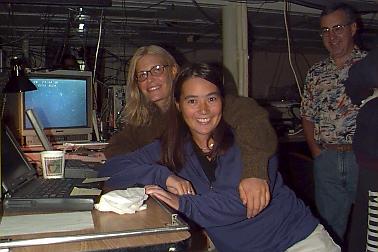
Ahoy from the NOAA ship, the Ron Brown! We're here sitting a top an underwater volcano called Axial Seamount. Our mission? To explore the deep. In particular, to seek out, observe, measure, and sample the spectacular life associated with hot water gushing out of the seafloor. These underwater hot springs are called hydrothermal vents. These vents spew water from temperatures close to ambient (which is about 2degC) up to 401degC. Most of the animals living around vents flourish in temperatures below 20degC. However, a vent creature has been discovered that thrives in water up to 80degC, the highest known temperature for any animal. Wow! That's like us living in a lobster pot. Not only do vent animals have to deal with high temperatures, but they are also exposed to chemicals and minerals which are normally toxic to most other life. On top of that, these guys live in the pitch black because sunlight cannot penetrate to these depths. That means no photosynthesis, which is the base of food chains for most other life on earth. So how do these creatures survive with no plants to eat? They depend on bizarre bacteria that use chemical energy in the vent water to produce organic carbon which in turn sustains them..
Who are "we"? We are Jean Marcus and Maia Tsurumi . Two graduate students studying various aspects of hot vent biology at the University of Victoria, Victoria, B.C., Canada. Various other researchers on the ship are interested in the microbiology, chemistry, and geology. But who's really interested in that boring stuff??? We like to study the cool critters found in this extreme environment. We are focusing on understanding the ecology of vent animals. I (Jean) am specifically looking at vent worms called polychaetes. I am trying to figure out what underlies their patchy distribution and abundance in a 60 m2 vent field on Axial Seamount. I (Maia) am also studying vent ecology. I am interested in all vent animals from the microscopic (but not the bacteria!) to the giant tubeworms at vent fields all over Axial Seamount and also two other locations on the Juan de Fuca Ridge. Two things I'm very curious about are the patchy distribution of some species along the Ridge and the controls on animal diversity in these crazy communities. On this cruise we are using a remotely operated submersible called ROPOS. We pilot the submersible from the ship and get real-time video, locations, and samples from the seafloor. That means we watch TV all day and night when the sub is roving around the bottom! Right now, we are over thirteen hours into our first dive and have already seen lots of strange things, including some newly formed vent sites and little scale worms munching on bacteria-covered rocks. On this dive, we hope to get a biological sample. This means that a robotic arm from the sub will reach out and grab a patch of animals, put them into a bullet-proof box (to protect them from the sub), and will eventually bring them to the surface. Shipboard, we sort through our sample, record our findings, and preserve the animals for future work back on shore. Oops, got to go--we've just been called back to the ROPOS control room!
August 27
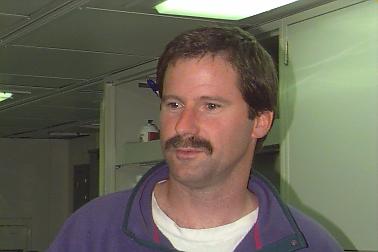
Hi. My name is Bill Chadwick and I am a geologist who studies volcanoes. I've worked on volcanoes on land like Mount St. Helens and Kilauea in Hawaii, but for the last 9 years I've been studying the volcanoes on the bottom of the ocean. That might seem like a funny place to study volcanoes, but it turns out that about 75% of the Earth's volcanic activity takes place on the ocean floor. This is because the Earth has a system of mid-ocean ridges all aroundit and in every ocean, and these ridges are places where tectonic plates are moving apart. As the plates spread, magma (molten rock from deep inside the Earth) moves up to fill the gap and some of it erupts on the seafloor as new lava flows. Geologist have known for many years that many eruptions must be taking place on the mid-ocean ridges every year, but before about 5 years ago no one had any idea when and where - there was no way to detect them. About 6 years ago, the technology was developed to detect seafloor eruptions as they are happening and since then we have detected 3 eruptions in the NE Pacific, one of which was this past January at Axial volcano, where we are now.
All of this makes the work I do very interesting and exciting, because it really feels like discovery. We know so little about mid-ocean ridge volcanoes and how they work that almost every thing we see and learn seems brand new. It is an incredible research opportunity for all of us, and it's fun to be figuring things out for the first time.
In my own research, I like to study the "active" and "dramatic" things that the Earth does - like when it erupts lava or when faults move during earthquakes. Some of the specific work I'll be doing on this cruise will be searching for where new lava might have come out during the January earthquake swarm. We still do not know *for sure* that lava erupted, but we think it did and we have some ideas of where to look for it with ROPOS. Tune in later to see if we find it! Another project will be recovering some instruments called "acoustic extensometers" with ROPOS that we deployed on the north rift zone of Axial in 1996, part of an experiment to measure actual "seafloor spreading" during volcanic events like the one that occurred in January. Pretty good timing, huh? I hope they worked! Another thing I'll be doing is conducting surveys with an instrument called an Imagenex scanning sonar mounted on ROPOS. This sonar can be used to make very detailed maps of small areas and we think that this will help us understand why hydrothermal vents occur where they do, and how they are related to the geology of Axial volcano. Thanks for your interest in our expedition and we're looking forward to sharing with you some of the excitement of that feeling of discovery.
(I also want to say "I miss you" to my 5-year old daughter Kelly who was crying her eyes out when daddy left Newport on the ship a few days ago one of the hardest parts of oceanography!)
August 26
Bob Embley, Chief Scientist
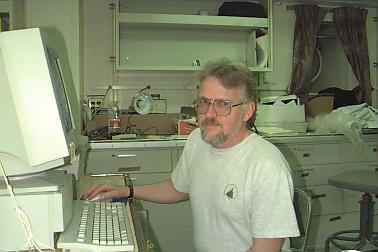
Hi Everyone, I'm Bob Embley, Chief Scientist of the first NeMO expedition. As I write this I can't help reflecting on how much has changed in oceanography since my first expedition 32 years ago. My first cruise on the VEMA in 1966 circled the North Atlantic taking samples and measurements over thousands of miles during the course of almost 6 months. Over the years there has been a steady increase in complexity of the tools that scientists bring on board research vessels in parallel with the sophistication of the vessels themselves. The RON BROWN is one of four state-of-the-art oceanographic vessels built in the 1990s with has capabilities almost unheard of 30 years ago. As an example, it can hold station over a spot on the seafloor with an accuracy of about 5 meters (~16 feet)! In 1966 we were fortunate at any given time to know our position within about half a mile!
You're probably wondering what a "Chief Scientist" does on an expedition like this. First, I should say that this is probably the most complex expedition I've ever been involved in. My colleagues and I have spent the last two years preparing for it! First, we had to develop the NeMO concept. Then we had to write "proposals", wherein we presented our scientific ideas and requested money to support the research. After that came the task of ensuring that we had access to both the RON BROWN and the ROPOS at the same time. So really the job of chief scientist starts long before the cruise begins. Now that we're at sea, I'm the primary contact person between the scientific party, the ship, and the ROPOS group. My job is mostly coordinator of the science program, making sure that everyone has a good chance to accomplish the goals stated in their proposals. Since there are 33 in the science party (the most I've ever been at sea with previously was about 25), this can be an interesting experience! In addition, I have my own scientific goals which are aimed at a better understanding of how mid-ocean volcanos form and interact with the ocean.
Tonight we are laying in "transponders", which are sound-emitting beacons placed on the seafloor to provide ROPOS with its location while its operating on the seafloor. Soon after we complete that sometime tomorrow afternoon, ROPOS will descend to the top of Axial Volcano for the first time. In February, I was on the first cruise to the site on the research vessel WECOMA after the "event". We measured large temperature anomalies in the water overlying the volcano but could not visit the seafloor. The brief view I had of the site in July from the porthole of the submersible Alvin revealed a volcanic landscape covered in places with large areas of bright white bacterial mat and warm water gushing from uplifted slabs of lava. Now we are poised over the volcano with ROPOS, whose lights, cameras, and specialized instrumentation will bring this unique group of biologists, microbiologists, chemists and geologists to this unique environment for the the next several weeks. Even though the ship will not move more than a few miles, I'm sure this journey will take me to at least as many interesting places as I visited on that first expedition more than 30 years ago.
All of us out here on the RON BROWN are looking forward to sharing this journey with you.
August 25, 1998
Susan Merle
August 25th, 2200
We are steaming towards Axial Volcano and hope to be on site by tomorrow afternoon. Most of the mechanical problems we were experiencing earlier have been resolved. The Imagenex survey system is now operating as it should be. The low-light digital camera cannot be used in real-time mode for the moment, but the data will be collected and referred to later. We are hoping for a fix for the camera before long. Relaying all the data up the cable from the ROPOS to the lab computers is a big challenge. It looks like the ROPOS team has ironed out most of the problems. We're all ready to begin working, tomorrow morning that is. At present most of the science crew are in their racks getting as much rest as they can while we are in transit. Tomorrow when we arrive on site the first order of operations will be to deploy the transponders we will be using to assist in navigating the ROV.
-Susan Merle